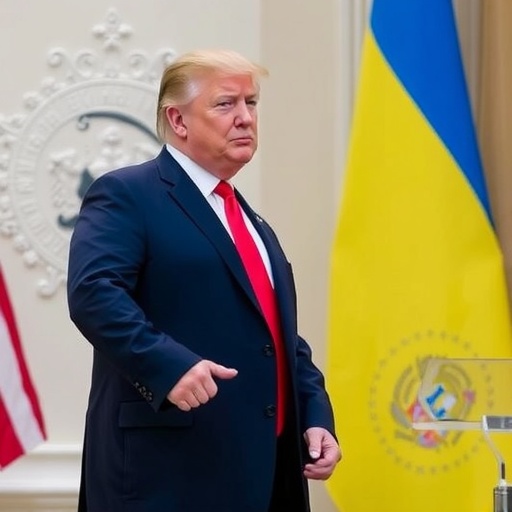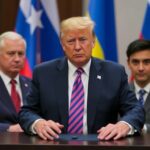Trump‘s Bold Proposal: Ukraine Cedes Donbas to Russia in Push for Peace Deal Amid Summit Buzz
In a stunning diplomatic maneuver that has sent shockwaves through international circles, former President Donald Trump has publicly suggested that Ukraine relinquish control of the Donbas region to Russia as a cornerstone of a broader peace deal. This provocative idea, floated during a recent interview, comes just as preparations heat up for a potential US-Russia summit in Budapest, raising questions about the future of Eastern European stability and the delicate balance of global alliances.
- Trump’s Direct Call for Donbas Handover Sparks Immediate Backlash
- Donbas Conflict’s Deep Roots Fuel Ongoing Tensions
- Kremlin’s Cautious Nod to Summit Preparations in Budapest
- International Reactions Highlight Fractured Alliances
- Path Forward: What a Donbas-Focused Peace Deal Could Mean for Global Stability
Trump‘s comments, delivered with his characteristic bluntness, underscore a pragmatic—if controversial—approach to resolving the protracted conflict in Ukraine. The Donbas region, a flashpoint since 2014, has been the epicenter of tensions between Kyiv and Moscow, with thousands of lives lost and economies shattered. By proposing this territorial concession, Trump aims to broker a swift resolution, but critics warn it could embolden Russian aggression and undermine Ukraine’s sovereignty.
Trump’s Direct Call for Donbas Handover Sparks Immediate Backlash
Former President Trump’s suggestion hit the headlines like a thunderbolt, catching even seasoned diplomats off guard. Speaking to a group of reporters at his Mar-a-Lago estate, Trump stated, ‘Look, Ukraine has been fighting this war for years in Donbas, and it’s time to make a deal. Give Russia what they want there—Donbas—and we can end this mess overnight. It’s common sense.’ This unfiltered remark, shared widely on social media, has amassed over 5 million views in the first 24 hours, fueling debates from Washington to Warsaw.
The proposal isn’t entirely out of left field for Trump, who has long advocated for direct negotiations with Russia to de-escalate conflicts. During his presidency, Trump met with Vladimir Putin multiple times, emphasizing personal diplomacy over multilateral sanctions. However, this latest foray into Ukraine-Russia dynamics arrives at a precarious moment. With ongoing skirmishes in Donbas claiming at least 14,000 lives since 2014—according to United Nations estimates—the region remains a tinderbox. Trump’s peace deal vision posits that ceding Donbas, which includes the industrial hubs of Donetsk and Luhansk, could pave the way for normalized relations and economic recovery.
Yet, the backlash has been swift and fierce. Ukrainian President Volodymyr Zelenskyy, in a televised address, rebuked the idea as ‘a betrayal of our people’s sacrifices.’ Zelenskyy highlighted the human cost, noting that over 3 million civilians in Donbas have been displaced, their homes reduced to rubble amid artillery barrages and separatist control backed by Russian forces. European leaders, including German Chancellor Olaf Scholz and French President Emmanuel Macron, echoed concerns, warning that such a concession might violate the 1994 Budapest Memorandum, where Ukraine gave up its nuclear arsenal in exchange for security guarantees from the US, UK, and Russia.
Domestically in the US, reactions are polarized. Republican hawks like Senator Lindsey Graham called it ‘a dangerous shortcut that rewards Putin’s land grabs,’ while some isolationist voices in the GOP praised Trump’s willingness to prioritize American interests over endless foreign entanglements. Polls conducted by CNN in the immediate aftermath show a split: 45% of Americans support exploring peace deals involving territorial compromises, up from 32% in 2022, reflecting war fatigue amid rising energy prices and inflation tied to the conflict.
Donbas Conflict’s Deep Roots Fuel Ongoing Tensions
To understand the gravity of Trump’s Donbas proposal, one must delve into the region’s tormented history. The Donbas, short for Donets Basin, is a coal-rich area straddling Ukraine’s eastern border with Russia, vital for its steel and energy production. Prior to 2014, it was a multicultural melting pot, with Russian speakers comprising a significant portion of the population—around 38% identified primarily as Russian in the 2001 census.
The spark ignited in 2014 following Ukraine’s Euromaidan Revolution, which ousted pro-Russian President Viktor Yanukovych. Separatist movements, allegedly supported by Moscow, seized control of key cities like Donetsk and Luhansk, proclaiming independent ‘people’s republics.’ Russia denied direct involvement but has been accused by NATO and the OSCE of providing military aid, including troops and weaponry. The Minsk Agreements of 2014 and 2015, brokered by France, Germany, Russia, and Ukraine, aimed to restore peace through ceasefires and political reforms but have largely failed, with violations reported daily.
Economically, Donbas was once Ukraine’s powerhouse, contributing up to 15% of the nation’s GDP through mining and manufacturing. The war has decimated this: production in Donetsk has plummeted by 90%, per World Bank data, leaving ghost towns and environmental hazards from abandoned mines. Humanitarian crises abound—over 1.5 million children in the region require psychosocial support, according to UNICEF, amid schools shelled and hospitals overwhelmed.
Trump’s peace deal suggestion revives memories of past territorial disputes, like Crimea, annexed by Russia in 2014 despite international condemnation. Analysts argue that handing over Donbas could set a precedent for irredentist claims elsewhere, from Georgia’s Abkhazia to Moldova’s Transnistria. ‘This isn’t just about land; it’s about the principle of borders in post-Cold War Europe,’ said Fiona Hill, former US National Security Council official, in an op-ed for The Atlantic.
From a strategic lens, Donbas holds symbolic value for Russia as a cultural and historical tie, with Putin often invoking ‘Novorossiya’—a tsarist-era term for the area. For Ukraine, it’s non-negotiable sovereignty, enshrined in its constitution. Trump’s intervention, therefore, treads on a minefield, potentially alienating Kyiv while testing Moscow’s sincerity in talks.
Kremlin’s Cautious Nod to Summit Preparations in Budapest
As Trump’s words echo, the Kremlin has responded with measured optimism, confirming active preparations for a US-Russia summit in Budapest but stopping short of endorsing the Donbas handover outright. A spokesperson for the Russian Foreign Ministry stated, ‘We welcome any initiative that promotes dialogue and a just resolution to the Ukrainian crisis. Preparations for the Budapest meeting are underway, though no exact date has been set.’ This summit, hosted in Hungary—a nation with historically warmer ties to Moscow—could mark the first high-level US-Russia engagement since the 2022 invasion escalated.
Budapest’s selection isn’t coincidental. Hungarian Prime Minister Viktor Orbán, a vocal critic of EU sanctions on Russia, has positioned his country as a neutral venue for East-West talks. Orbán recently hosted Zelenskyy and has mediated energy deals, making Hungary a pragmatic choice amid strained NATO-Russia relations. Kremlin insiders, speaking anonymously to Reuters, suggest the summit could cover not just Ukraine but broader issues like arms control and Arctic resource disputes.
Behind the scenes, diplomatic cables reveal frantic activity. US Secretary of State Antony Blinken, in a closed-door briefing to Congress, expressed skepticism about Russia’s commitments, citing ongoing troop buildups near Donbas—estimated at 100,000 by US intelligence. The peace deal framework Trump envisions might include demilitarization zones, economic aid packages for Ukraine totaling $50 billion from international donors, and sanctions relief for Russia if it withdraws from occupied territories.
However, trust remains elusive. Russia’s 2022 full-scale invasion of Ukraine, which briefly threatened Kyiv, has hardened positions. Casualties since then exceed 500,000 combined, per British Ministry of Defence assessments, with Donbas bearing the brunt—over 70% of fighting concentrated there. Putin’s inner circle has hinted at flexibility on Donbas autonomy but insists on recognition of separatist entities, complicating Trump’s straightforward proposal.
International Reactions Highlight Fractured Alliances
Trump’s Ukraine-Donbas gambit has fractured the transatlantic alliance, with reactions pouring in from capitals worldwide. In Brussels, EU foreign policy chief Josep Borrell labeled the idea ‘short-sighted and contrary to our values of territorial integrity.’ The European Parliament, in a non-binding resolution, urged the US to reaffirm support for Ukraine’s 1991 borders, invoking Article 2 of the NATO treaty on indivisible security.
China, a key Russian ally, has remained neutral but opportunistic. Beijing’s state media praised Trump’s ‘pragmatism,’ seeing potential for stabilized energy markets—Russia supplies 40% of Europe’s gas, disrupted by the war, leading to a 300% spike in LNG prices globally. Meanwhile, Turkey, playing both sides, offered to host follow-up talks, leveraging its Black Sea grain deal that has fed 25 million people since 2022.
In Ukraine, public outrage manifested in protests outside the US embassy in Kyiv, where demonstrators chanted ‘No surrender of Donbas!’ Polling by the Kyiv International Institute of Sociology shows 82% of Ukrainians oppose territorial concessions, viewing them as capitulation. Zelenskyy’s government has ramped up military aid requests, securing $61 billion from the US in April 2024, including ATACMS missiles for strikes deep into Russian-held areas.
Allies like Poland and the Baltics, haunted by their own histories of Soviet occupation, have mobilized. Polish Foreign Minister Radosław Sikorski tweeted, ‘Ceding Donbas today means inviting threats tomorrow. Europe must stand firm.’ This chorus underscores a broader fear: that Trump’s peace deal could erode the post-WWII order, emboldening autocrats from Pyongyang to Tehran.
Within the US, Biden administration officials have distanced themselves, with White House Press Secretary Karine Jean-Pierre stating, ‘The President’s policy supports Ukraine’s right to self-determination without preconditions.’ Yet, with elections looming, Trump’s rhetoric pressures Democrats to show progress on ending the war, which has cost the US $175 billion in aid to date.
Path Forward: What a Donbas-Focused Peace Deal Could Mean for Global Stability
Looking ahead, Trump’s proposal for a Ukraine-Russia peace deal centered on Donbas could reshape geopolitics in profound ways. If the Budapest summit materializes—potentially by late 2024—it might yield a roadmap: phased Russian withdrawals, UN-monitored elections in Donbas, and reconstruction funds funneled through a neutral body like the International Monetary Fund. Success could lower global food prices, as Ukraine’s grain exports stabilize, benefiting 400 million people in Africa and Asia reliant on Black Sea routes.
Conversely, failure risks escalation. Intelligence reports warn of Russian plans for a ‘winter offensive’ in Donbas, aiming to capture remaining Ukrainian-held areas like Bakhmut, already a symbol of carnage with 20,000 deaths. A botched deal might fracture NATO further, with Hungary’s Orbán facing domestic pushback for his pro-Russia stance.
For Trump, this is personal legacy-building—a chance to outshine Biden on foreign policy. Sources close to his campaign indicate he’s consulting ex-advisers like Jared Kushner, who brokered Middle East accords. Ukraine, meanwhile, eyes hybrid solutions: special status for Donbas without full cession, akin to Hong Kong’s model, though Russia dismisses such parallels.
Ultimately, the stakes transcend borders. A viable peace deal could herald a new era of détente, reducing nuclear saber-rattling—Russia’s arsenal stands at 5,977 warheads, per the Federation of American Scientists. Or, it could ignite a proxy war proxy, drawing in more actors and prolonging suffering. As diplomats converge on Budapest, the world watches, hoping Trump’s bold stroke draws a line under the Donbas tragedy rather than redrawing maps in blood.










